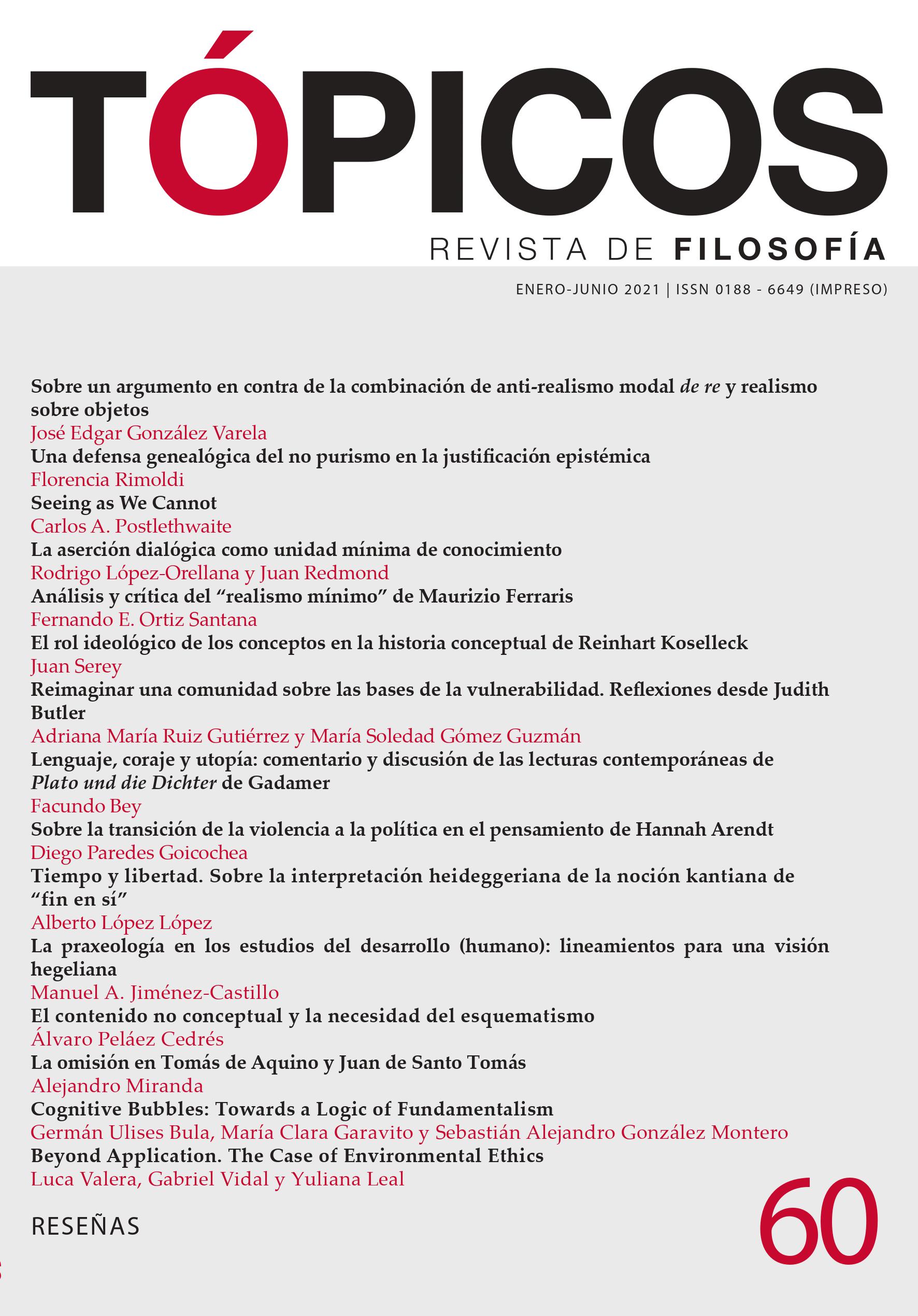Publicado 2020-10-27
Palabras clave
- percepción,
- cognición,
- contradicciones verdaderas,
- principio de no contradicción,
- penetrabilidad cognitiva de la percepción
- restricciones perceptuales. ...Más
Cómo citar
Resumen
La creencia de que el pato-conejo de Jastrow (J) es un dibujo tanto de la cabeza de un pato como un dibujo de la cabeza de un conejo viola el principio de no contradicción (LNC), como lo hace también la creencia de que J parece algo distinto de todo lo que J pueda parecer. Llamemos B1 a la primera creencia y B2 a la segunda. Yo argumento que B1 y B2 son creencias racionales, aunque contradictorias, y concluyo que debemos reconsiderar el estatus del LNC como requisito fundamental para la racionalidad. En contraste con B1 y B2, nuestras experiencias correspondientes de J sí cumplen con el LNC. Es decir, no podemos ver J como un pato y como un conejo al mismo tiempo (E1), ni J parece algo distinto de lo que J nos pueda parecer (E2). Puesto que no hay una explicación satisfactoria respecto de por qué no podemos ver J como las contradicciones E1 o E2 (a pesar de que nuestras creencias correspondientes sobre J son las contradicciones B1 y B2), yo propongo que el LNC es tan sólo una hipótesis empírica acerca de los límites de nuestra percepción.
Referencias
- Addis, M. (2010). Seeing As. In E. Goldstein (ed.), Encyclopedia of Perception. (pp. 877-878). Sage Publications. Andersen, R. & Buneo, C. (2002). Intentional Maps in Posterior Parietal Cortex. Annual Review of Neuroscience, 25(1), 189-220.
- Aristotle. (1928). The Works of Aristotle Translated into English. W. D. Ross (ed.). Clarendon Press.
- Beall, J. C. (2000). Is the Observable World Consistent? Australasian Journal of Philosophy, 78(1), 113-118.
- Berman, R. & Colby, C. (2009). Attention and Active Vision. Vision Research, 49(10), 1233-1248.
- Blake, R. (2009). Multistable Perception. In T. Bayne, A. Cleeremans & P. Wilken (eds.), The Oxford Companion to Consciousness. (pp. 455-457). Oxford University Press.
- Blake, R. & Logothetis, N.K. (2002). Visual Competition. Nature Reviews Neuroscience, 3(1), 13-21.
- Chen, Q., Marshall, J., Weidner, R. & Fink, G. (2008). Zooming In and Zooming Out of the Attentional Focus: An fMRI Study. Cerebral Cortex, 19(4), 805-819.
- Churchland, P. M. (1988). Perceptual Plasticity and Theoretical Neutrality: A Reply to Jerry Fodor. Philosophy of Science, 55, 167-187.
- DeGraaf, T., DeJong, M., Goebel, R., VanEe, R. & Sack, A. (2011). On the Functional Relevance of Frontal Cortex for Passive and Voluntarily Controlled Bistable Vision. Cerebral Cortex, 21(10), 2322-2331.
- Dennett, D. (2002). Seeing Is Believing―Or Is It? In A. Noë and E. Thompson (eds.), Vision and Mind. (pp. 481-496). MIT Press.
- Dretske, F. (2006). Perception without Awareness. In T. Gendler & J. Hawthorne (eds.), Perceptual Experience. (pp. 147-180). Oxford University Press.
- He, S. (2010). Bistable Perception. In E. Goldstein (ed.), Encyclopedia of Perception. (pp. 213-215). Sage Publications.
- Heekeren, H. R., Marrett, S. & Ungerleider, L. G. (2008). The Neural Systems that Mediate Human Perceptual Decision Making. Nature Reviews Neuroscience, 9, 467-479.
- Helmholtz, H. (2013). Treatise on Physiological Optics, Volume III. Dover Publications.
- Hohwy, J., Roepstorff, A. & Friston, K. (2008). Predictive Coding Explains Binocular Rivalry: An Epistemological Review. Cognition, 108(3), 687-701.
- Ilg, R., Wohlschläger, A., Burazanis, S., Wöller, A., Nunnemann, S. & Mühlau, M. (2008). Neural Correlates of Spontaneous Impression Switches in Ambiguous Stimuli: An Event‐Related fMRI Study. European Journal of Neuroscience, 28(11), 2325-2332.
- Koch, C. (2004). The Quest for Consciousness: A Neurobiological Approach. Roberts & Co.
- Leibniz, G. W. (1989). New System of Nature. In R. Ariew and D. Garber (eds.), G. W. Leibniz: Philosophical Essays. (pp. 138-144). Hackett Classics.
- Leopold, D. A. & Logothetis, N. K. (1999). Multistable Phenomena: Changing Views in Perception. Trends in Cognitive Sciences, 3(7), 254-264.
- Macpherson, F. (2006). Ambiguous Figures and the Content of Experience. Noûs, 40(1), 82-117.
- Macpherson, F. (2015). Cognitive Penetration and Nonconceptual Content. In T. Gendler & J. Hawthorne (eds.), The Cognitive Penetrability of Perception. (pp. 331-358). Oxford University Press.
- Maier, A. & Leopold, D. (2009). Binocular Rivalry. In T. Bayne, A. Cleeremans & P. Wilken (eds.), The Oxford Companion to Consciousness. (pp. 105-107). Oxford University Press.
- Orlandi, N. (2011). The Innocent Eye: Seeing-As without Concepts. American Philosophical Quarterly, 48(1), 17-31.
- Palmer, S. (1999). Vision Science: Photons to Phenomenology. MIT Press.
- Pettigrew, J. (2001). Searching for the Switch: Neural Bases for Perceptual Rivalry Alternations. Brain and Mind, 2(1), 85-118.
- Priest, G. (1999). Perceiving Contradictions. Australasian Journal of Philosophy, 77(4) 439-446.
- Priest, G. (2008). Doubt Truth to Be a Liar. Oxford University Press.
- Siegel, S. (2016). The Contents of Perception. In E. Zalta (ed.), The Stanford Encyclopedia of Philosophy. URL: https://plato.stanford.edu/archives/win2016/entries/perception-contents/.
- Sterzer, P., Kleinschmidt, A. & Rees, G. (2009). The Neural Bases of Multistable Perception. Trends in Cognitive Sciences, 13(7), 310-318.
- Stokes, D. (2015). Towards a Consequentialist Understanding of Cognitive Penetration. In T. Gendler, and J. Hawthorne (eds.), The Cognitive Penetrability of Perception. (pp. 75-100). Oxford University Press.
- Vernet, M., Brem, A. K., Farzan, F. & Pascual-Leone, A. (2015). Synchronous and Opposite Roles of the Parietal and Prefrontal Cortices in Bistable Perception: A Double-Coil TMS–EEG Study. Cortex, 64, 78-88.
- Wilson, H. R. (2003). Computational Evidence for a Rivalry Hierarchy in Vision. Proceedings of the National Academy of Sciences of the United States, 100(24), 14499-14503.
- Wittgenstein, L. (2001). Philosophical Investigations. Blackwell.
- Wohlschlaeger, A. (2000) Visual Motion Priming by Invisible Actions. Vision Research, 40, 925–930.






